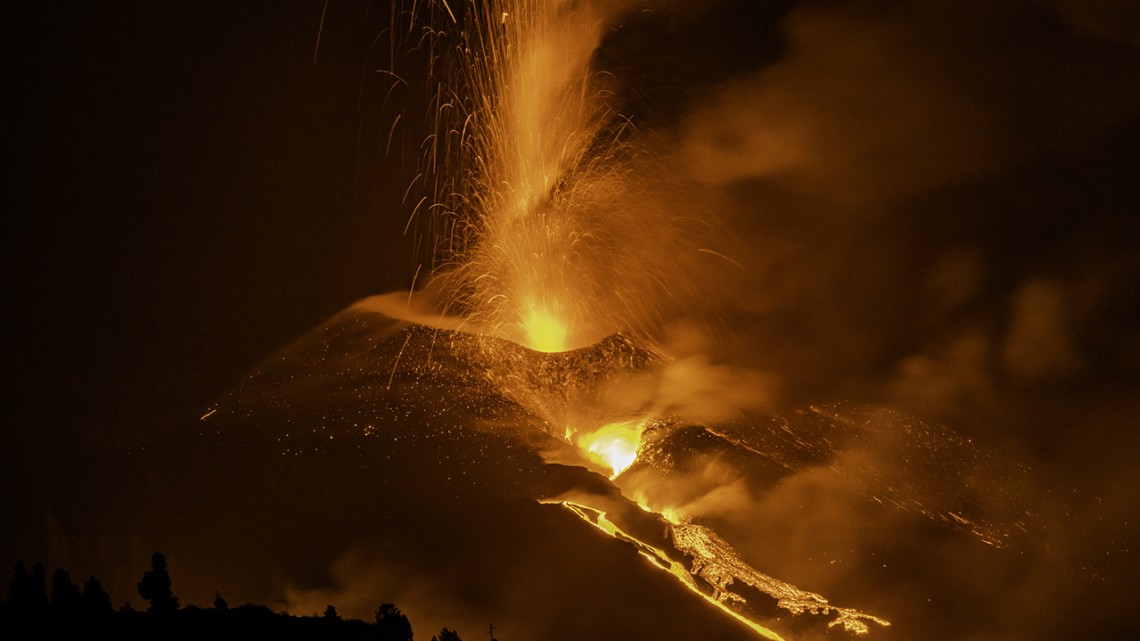
The newly erupted Cumbre Vieja volcano on La Palma in the Canary Islands illuminates the night sky in early October.
Cornell scientists to join team for live volcanic eruption
By Blaine Friedlander
Among the Cornell faculty, Esteban Gazel arguably conducts the hottest research. But this time the geochemist should be safe from magma heat.
Gazel, associate professor in the Department of Earth and Atmospheric Sciences, and doctoral student Kyle Dayton will join a small, elite team of international researchers on Oct. 21 at the newly erupted Cumbre Vieja volcano on the island of La Palma in the Canary Islands – off the coast of western Africa.
“The opportunity to be near an active volcanic during an eruption is rare,” Gazel said. “Volcanoes erupt all the time, but not all volcanoes are accessible. This volcano has been well monitored, well understood and we have enough background data now to validate any new measurements.”
Dayton and Gazel will collect on-site micro and nano samples of the air carried by the wind to Tenerife, the largest of the Canary Islands, as well as the island of La Palma, as part of a NASA-supported project to investigate the global effects of volcanic ash on the Earth systems in collaboration with department faculty members Natalie Mahowald, the Irving Porter Church Professor of Engineering; and Matthew Pritchard, professor of earth and atmospheric sciences. They will also sample crystals containing glass inclusions to determine the volcano’s volatile budgets, including carbon dioxide emissions. A 2018 Cornell Atkinson Rapid Response Fund award led to the NASA grant.
Gazel – a fellow at the Cornell Atkinson Center for Sustainability, and at Cornell’s Carl Sagan Institute – was invited by research organizers Francisco José Pérez Torrado and Juan Carlos Carracedo, professors at the University of Las Palmas de Gran Canaria and by Valentin Troll, chair of petrology, Uppsala University, Sweden, to join their team.
A half-century ago, volcanoes on the Canary Islands were believed to emerge from Earth-crust fractures extending from the continent of Africa. Plate tectonics and the concept of mantle plumes, thermal anomalies rising from the interior of the Earth, was a new idea in the 1970s, so the young Carracedo suggested that the volcanoes were formed due to Earth’s plates moving on top of a mantle plume – the same process that formed the Hawaiian Islands. This is the generally accepted science today.
Gazel calls Cumbre Vieja’s Sept. 19 eruption a non-aggressive one. People living around the volcano have been evacuated, but many La Palma buildings and infrastructure in the lava path will be destroyed. The volcano erupted mildly in 1971 and in 1949; Gazel said the 2021 eruption shows no signs of slowing down.
For Dayton, who has been a doctoral student for 18 months, this will be her first trip to the Canary Islands.
“When I started graduate school, I knew I was going to study the Canary Islands,” Dayton said. “I set my phone to give me earthquake notifications in the Canaries. They're not big earthquakes. No one feels them until the actual eruption, but it’s how we can tell that magma is moving and that the Earth’s fluids and gases and magmas are traveling up to the surface and going under the islands.”
Dayton started receiving tiny earthquake notifications in December 2020. “While I was cooking Christmas dinner,” she said, “suddenly, my phone started to go off and it was so exciting to know that the mantle plume I've been studying, started to do things that I can see in real time.
This semester, Gazel has been teaching “Volcanology” (EAS 4580/6580.) According to his class syllabus, coincidentally, he will be lecturing on “Volcanic Hazards and Monitoring” and “Lava Flows” in early November.
“Working on an eruption that is active right now and given the technology we have, we can follow the magma rising to the surface,” Gazel said. “We can correlate data, so we are able to understand the eruption from different dimensions.”
Said Gazel: “All of this matters so that we can understand the internal dynamics of a planet and the mechanism behind eruptions. Volcanoes act as probes to understand the interior of the Earth.”
Gazel and Dayton will keep the volcanology class updated via a dedicated Slack channel and social media during the field expedition.
Cornell’s Department of Earth and Atmospheric Sciences is part of the College of Engineering and the College of Agriculture and Life Sciences.
Media Contact
Get Cornell news delivered right to your inbox.
Subscribe
